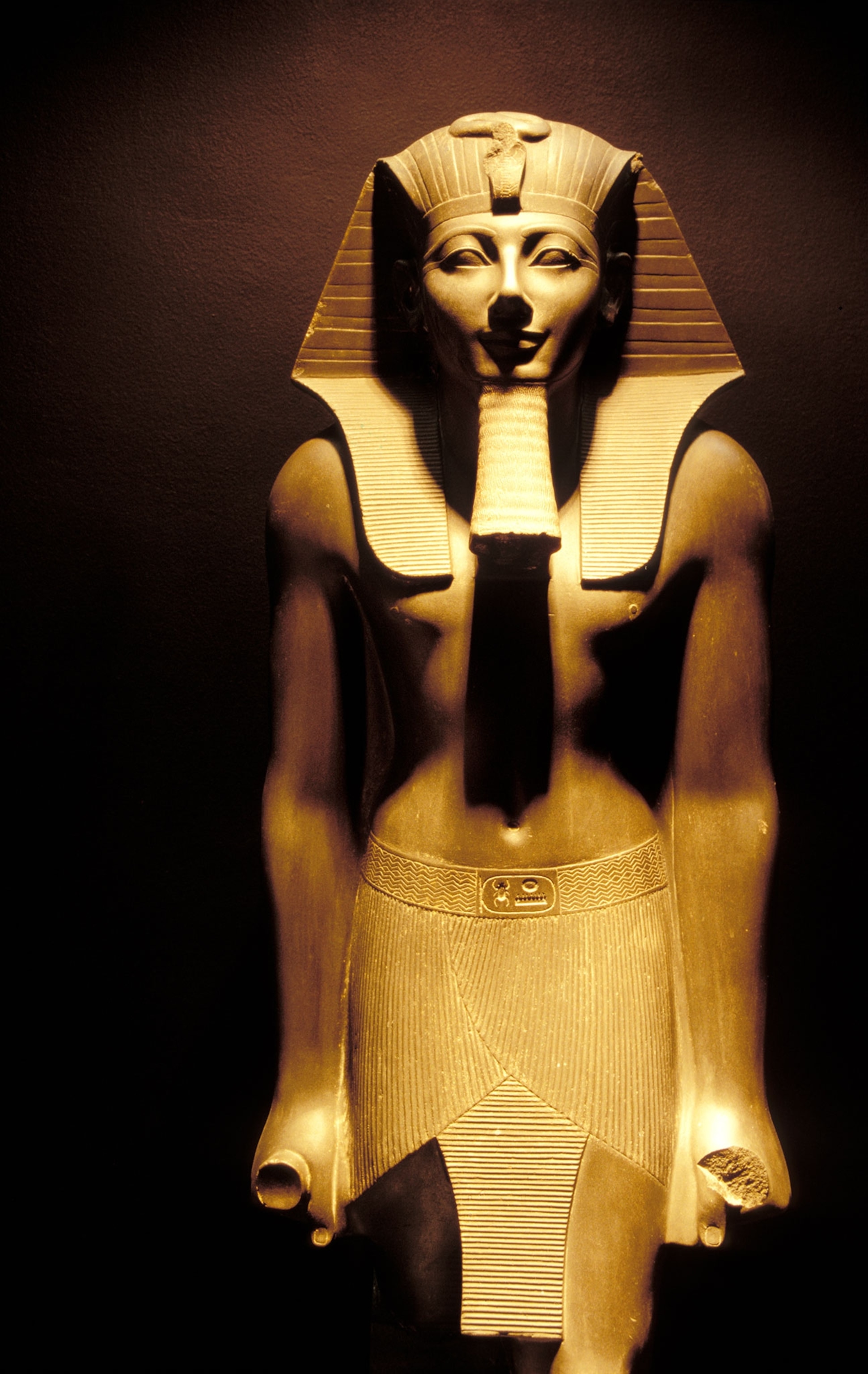
Thutmose III (unknown-ca 1426 B.C.) wasted no time making a name for himself, once he was out from under the shadow of the over-reaching regent-turned-pharaoh Hatshepsut. He transformed Egypt from an inward-looking kingdom into a triumphant, conquering nation. And he established a reputation as a brilliant military strategist, one whom later historians would call the “Napoleon of Egypt.”
Just a few months after coming to power, Thutmose III marched with an army of 20,000 soldiers to Megiddo, in modern-day northern Israel—a site better known by its Greek name, Armageddon. A coalition of opponents had gathered there, outside the city. Scribes traveled with Thutmose III’s forces and recorded the campaign’s details, an invaluable chronicle now known as the Annals of Thutmose III.
The pharaoh defied his advisers and surprised his foes by surging through a treacherous mountain pass to mount a deadly direct attack on Megiddo. He rode up front during that perilous advance to show that he trusted in the gods to protect him and his troops, and indeed, all made it through the pass unscathed. Then he entered battle at Megiddo “on a chariot of fine gold, decked in his shining armor,” dazzling and intimidating his opponents, who soon gave up the fight and retreated to their last bastion of safety within the city walls. Thutmose III laid siege to Megiddo for seven months, mercilessly starving out its remaining inhabitants until they surrendered.
Thutmose III flexed his military might repeatedly: in Nubia, in Phoenician ports, in the valuable trade center of Kadesh, and in the kingdom of Mitanni, in modern-day Syria and Turkey. Over the course of 17 campaigns, he secured more territory than any other pharaoh. By the end, he controlled Egypt’s largest ever empire. (Learn more about King Tut and his time as pharoah.)

The spoils from Thutmose III’s military campaigns—including plunder, taxes, and tribute—vastly enriched Egypt’s treasury and made him the richest man in the world at the time. But he also secured human capital from his captured lands. The sons of conquered rulers were taken to Egypt and educated at court. Acclimated to Egyptian ways, those offspring returned home sympathetic to Egyptian rule.
Unlike one of his later successors, Ramses II—who exaggerated his military achievements—Thutmose III earned the triumphs recorded on the numerous monuments he built. His annals were inscribed on the sanctuary walls at the great Temple of Amun at Karnak. The Festival Hall there depicts the fauna and flora—including 275 plants—he collected on his Asian campaigns. He installed obelisks at Karnak and built the sun god temple at Heliopolis. And by destroying—albeit incompletely—references to Hatshepsut and her reign, Thutmose III fashioned a direct line to his eponymous predecessors, strengthening his claim and his legacy as the rightful and most powerful ruler of Egypt.
You May Also Like
Go Further
Animals
- These pelicans are starving to death—despite plenty to eatThese pelicans are starving to death—despite plenty to eat
- The world's largest fish are vanishing without a traceThe world's largest fish are vanishing without a trace
- We finally know how cockroaches conquered the worldWe finally know how cockroaches conquered the world
- Why America's 4,000 native bees need their day in the sunWhy America's 4,000 native bees need their day in the sun
- Crowdsourcing an anti-poaching movement in South Africa
- Paid Content
Crowdsourcing an anti-poaching movement in South Africa
Environment
- 2024 hurricane season forecasted to be record-breaking year2024 hurricane season forecasted to be record-breaking year
- Connecting a new generation with South Africa’s iconic species
- Paid Content
Connecting a new generation with South Africa’s iconic species - These images will help you see coral reefs in a whole new wayThese images will help you see coral reefs in a whole new way
- What rising temps in the Gulf of Maine mean for wildlifeWhat rising temps in the Gulf of Maine mean for wildlife
- He’s called ‘omacha,’ a dolphin that transforms into a man. Why?He’s called ‘omacha,’ a dolphin that transforms into a man. Why?
History & Culture
- The tragic backstory of one of the most haunted roads in AmericaThe tragic backstory of one of the most haunted roads in America
- The missing heiress at the center of New York’s oldest cold caseThe missing heiress at the center of New York’s oldest cold case
- When a people's stories are at risk, who steps in to save them?When a people's stories are at risk, who steps in to save them?
- I wrote this article with a 18th century quill. I recommend it.I wrote this article with a 18th century quill. I recommend it.
- Why this Bronze Age village became known as ‘Britain’s Pompeii’Why this Bronze Age village became known as ‘Britain’s Pompeii’
- These modern soldiers put Bronze Age armor to the testThese modern soldiers put Bronze Age armor to the test
Science
- How being the oldest or youngest sibling shapes your personalityHow being the oldest or youngest sibling shapes your personality
- Tuberculosis is rising in the U.S. again. How did we get here?Tuberculosis is rising in the U.S. again. How did we get here?
- Are ultra-processed foods as addictive as cigarettes?Are ultra-processed foods as addictive as cigarettes?
- Epidurals may do more than relieve pain—they could save livesEpidurals may do more than relieve pain—they could save lives
- Why the world's oldest sport is still one of the best exercisesWhy the world's oldest sport is still one of the best exercises
Travel
- The best way to experience Slovenian cuisine? On two wheelsThe best way to experience Slovenian cuisine? On two wheels
- Flying taxis may be landing soon. Here's what to knowFlying taxis may be landing soon. Here's what to know
- A gastronomic guide to Georgia's best wineries and restaurants
- Paid Content
A gastronomic guide to Georgia's best wineries and restaurants - How to plan the ultimate island-hopping adventure in ScotlandHow to plan the ultimate island-hopping adventure in Scotland




